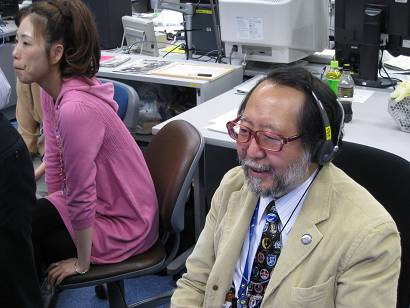This is an archive of information released in the past.
Disclaimer: It may contain broken links or outdated information. Some parts may not function in current web browsers.
*Visit https://humans-in-space.jaxa.jp/en/ for the latest information.

Experiment
- News
- Kibo Utilization Strategy
- Kibo Utilization Plan
- List of JAXA's Utilization Themes
- Experiment Facilities
- Space Environment Utilization
- Archive
Neuro Rad Experiment Begins
* All times are Japan Standard Time (JST)
Biological Effects of Space Radiation and Microgravity on Mammalian Cells (Neuro Rad)*, which uses the Cell Biology Experiment Facility (CBEF) in Kibo, began aboard the International Space Station (ISS).
*Principal Investigator (PI): Hideyuki Majima, Professor of Kagoshima UniversitySamples for the experiment were launched aboard the space shuttle Discovery (STS-131 mission) on April 5, 2010.
At 8:45 p.m. on April 8, the Neuro Rad experiment began with commands sent from the Tsukuba Space Center (TKSC).
The Neuro Rad experiment tries to examine biological effects of space radiations on human nerve cells using two different approaches.
One approach will see what types of genes are affected by space radiation. The other approach will determine a gene that plays a key role in mitochondria-induced apoptosis (programmed cell death).
In space, the nerve cell samples will be cultured at 37 degrees Celsius in the microgravity compartment and in the 1G compartment of the CBEF. On Day15 and Day29, the nerve cell samples will be chemically fixed and frozen to be returned to the ground.
Once the samples are returned, the team will analyze the samples to examine gene expressions and activities. The team will focus on the genes involved in mitochondrial activities, which produce energy in a cell, and protein activities.
It is known that space radiation directly affects genes and produces active oxygen in a cell. The produced active oxygen is known as an inducing factor of cell malfunction and cell aging. Using the nerve cell samples, the team will investigate the substances affected by active oxygen, and or the active oxygen scavenging enzymes to determine indirect effects of space radiation on cells.
This experiment also tries to determine mitochondria-induced and apoptosis-induced gene / protein activities. The team hopes to obtain useful information about effects of long-term space radiation exposure on nerve cells.
The experiment will continue until May 6, 2010. The samples will be returned to the ground aboard the space shuttle Atlantis on the STS-132 mission.
Special Message from Principal Investigator (PI)
The team visited NASA's Kennedy Space Center (KSC) for sample preparation. During the last three days before launch, we were so busy that we could take only seven hours of sleep in the three days. We could see the successful launch of the space shuttle Atlantis at KSC. Today, our samples were transferred to the Kibo module. We thank the people who have supported the project.

Professor Majima (right) monitoring the experiment
at User Operations Area (UOA) of TKSC
*All times are Japan Standard Time (JST)
| Copyright 2007 Japan Aerospace Exploration Agency | Site Policy |